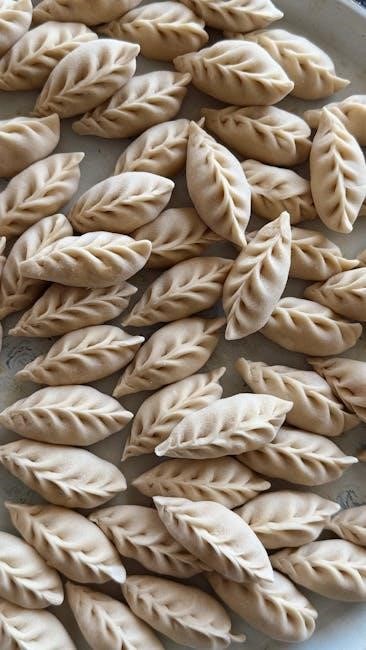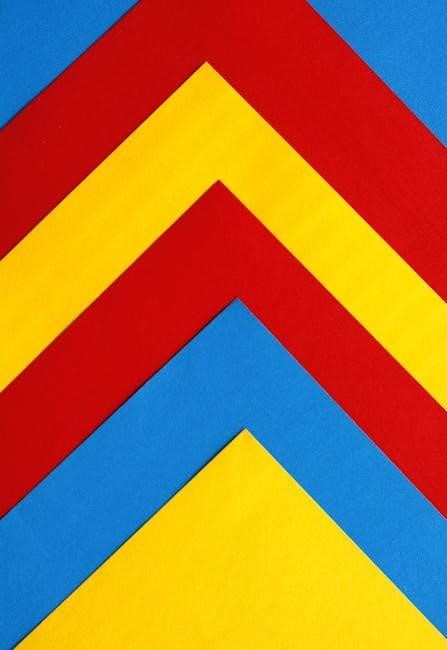veneer shape guide
VENeer shape guide‚ your comprehensive resource for understanding the importance of veneer shapes in both dental and wood applications. This guide explores how veneer shapes enhance aesthetics and functionality‚ offering insights into selecting the perfect shapes for your needs. Whether for a dazzling smile or exquisite furniture‚ mastering veneer shapes ensures stunning results. Discover how shape‚ size‚ and color converge to create harmony and beauty.
Understanding the Importance of Veneer Shapes
The shape of veneers plays a pivotal role in achieving both aesthetic and functional goals‚ whether in dental applications or woodworking. For dental veneers‚ the shape directly influences the appearance of your smile‚ complementing facial features and addressing imperfections like misaligned or uneven teeth. In woodworking‚ the shape of wood veneer determines the design and functionality of furniture or decorative elements. Properly shaped veneers ensure harmony‚ balance‚ and a natural look in both contexts. Understanding veneer shapes is essential for making informed decisions‚ as they significantly impact the final outcome. This guide will help you grasp the nuances of veneer shapes and their role in creating stunning results for teeth and wood surfaces alike.
Overview of Dental and Wood Veneer Shapes
Dental and wood veneer shapes serve distinct purposes‚ each tailored to enhance their respective applications in transforming appearances and creating durable‚ attractive surfaces. Dental veneers‚ crafted from materials like porcelain or composite resin‚ are designed to correct imperfections and enhance smile aesthetics‚ while wood veneers are applied in furniture and decor to achieve sophisticated designs. Both require precise shaping to ensure a seamless fit‚ providing a natural look whether on teeth or wood surfaces. This guide explores these aspects‚ offering insights to help readers make informed decisions for their specific needs‚ ensuring functional and visually appealing results in both cosmetic dentistry and woodworking projects.

Dental Veneer Shapes
Dental veneer shapes are crafted to correct imperfections and enhance smiles‚ offering a natural appearance. They are tailored to complement facial features and tooth alignment‚ ensuring a radiant look.

What Are Dental Veneers?
Dental veneers are thin‚ custom-made shells designed to cover the front surface of teeth‚ addressing imperfections like discoloration‚ chips‚ gaps‚ or misalignment. Crafted from porcelain or composite resin‚ they are durable and natural-looking. Veneers are bonded to teeth to enhance aesthetics and restore confidence. They are ideal for correcting minor flaws and achieving a uniform smile. The process involves minimal tooth preparation‚ making them a popular choice in cosmetic dentistry. Available in various shapes‚ sizes‚ and colors‚ veneers are tailored to match individual facial features and tooth alignment‚ ensuring a seamless and radiant result.
Types of Dental Veneers: Porcelain and Composite Resin
Dental veneers are primarily available in two materials: porcelain and composite resin. Porcelain veneers are highly durable and resistant to stains‚ offering a natural‚ translucent appearance that mimics real teeth. They are crafted in a dental lab‚ ensuring a precise fit and aesthetic appeal. Composite resin veneers‚ on the other hand‚ are made from a mixture of plastic and glass particles. They are less expensive and can often be completed in a single visit. Composite veneers are also more easily repairable than porcelain. Both options provide excellent results‚ but the choice depends on factors like budget‚ desired longevity‚ and the extent of tooth correction needed. Your dentist can help determine the best material for your specific needs.
How Veneer Shapes Complement Facial Features
Veneer shapes are carefully designed to complement facial features‚ ensuring a harmonious and natural appearance. For round faces‚ longer and rounded veneers balance the width‚ while oval faces benefit from longer‚ more pronounced shapes to enhance symmetry. Heart-shaped faces are paired with shorter‚ rounded veneers to soften the jawline‚ and square faces are complemented by rounded veneers to reduce angularity. The goal is to create proportion and balance‚ aligning the smile with the overall facial structure. By customizing veneer shapes to individual facial contours‚ patients achieve a more cohesive and aesthetically pleasing result. This personalized approach ensures that the veneers enhance the smile while maintaining facial harmony‚ offering a transformative yet natural-looking outcome.
Choosing the Right Veneer Shape for Your Face Shape
Choosing the right veneer shape for your face shape involves understanding how different veneer shapes complement various facial structures. For round faces‚ longer and rounded veneers can create a slimming effect‚ making the face appear longer. Oval faces benefit from longer and more pronounced veneers‚ which enhance symmetry and balance. Heart-shaped faces are well-suited with shorter and rounded veneers to soften the jawline‚ while square faces can be complemented by rounded veneers to reduce angularity. The goal is to achieve proportion and balance‚ ensuring the veneers align with the overall facial structure. Customizing veneer shapes to individual facial contours helps create a cohesive and aesthetically pleasing result‚ offering a natural-looking transformation.
How to Select Veneer Color and Size for a Natural Look
Selecting the right veneer color and size is crucial for achieving a natural appearance. The color should complement your skin tone and the shade of your natural teeth‚ ensuring a seamless blend. For a realistic look‚ choose veneers with translucency to mimic the light-reflection properties of enamel. When it comes to size‚ proportionality is key. Veneers should align with the size of your natural teeth and facial features‚ avoiding overly large or small shapes that might look unnatural. Digital smile simulations can help visualize how different shades and sizes will appear on your smile. The goal is to create harmony between your veneers and existing dental structure for a cohesive‚ natural aesthetic.

Wood Veneer Shapes and Applications
Wood veneer shapes offer versatility in furniture and decor‚ enhancing grain patterns for aesthetic appeal. Various cuts and applications allow for stunning designs‚ from intricate patterns to smooth surfaces.
Understanding Wood Veneer and Its Uses
Wood veneer is a thin layer of wood sliced from high-quality logs‚ used to enhance the appearance of surfaces. It is widely applied in furniture‚ cabinetry‚ and decorative paneling due to its natural beauty and durability. Available in various species and cuts‚ such as rotary‚ quarter‚ and plain sliced‚ wood veneer offers versatility in design. It is often used to create intricate patterns‚ uniform textures‚ or to match specific aesthetic preferences. The process involves cutting veneer into precise shapes and sizes‚ then applying it to surfaces using specialized tools and adhesives. Wood veneer is a cost-effective alternative to solid wood‚ providing a premium look without the expense; Its applications range from modern to traditional designs‚ making it a popular choice for craftsmen and designers alike. Properly finished‚ wood veneer adds elegance and sophistication to any project‚ ensuring long-lasting results.
Types of Wood Veneer Cuts: Rotary‚ Quarter‚ and Plain Sliced
Wood veneer is crafted using three primary cutting methods‚ each yielding distinct visual and functional characteristics. The rotary cut involves slicing the log with a blade as it rotates‚ producing wide‚ continuous sheets with a consistent grain pattern‚ ideal for wrapping surfaces seamlessly. The quarter cut slices the log at a 90-degree angle to the growth rings‚ resulting in straight‚ vertical grain lines and enhanced stability‚ making it suitable for modern designs. Lastly‚ the plain sliced method cuts parallel to the growth rings‚ creating varied‚ natural grain patterns‚ often featuring flake figures‚ which are particularly striking in species like oak. Each cut type offers unique aesthetic and structural benefits‚ allowing for tailored applications in furniture‚ paneling‚ and decorative projects.
Shaping Wood Veneer for Furniture and Decor
Shaping wood veneer requires precision and the right tools to achieve desired forms for furniture and decor. Utility knives‚ veneer saws‚ and metal straight edges are essential for cutting veneer into intricate patterns or curved designs. Trimming excess material with a razor blade or sanding edges ensures smooth‚ professional finishes. For complex shapes‚ bending veneer against the grain can create stunning curved surfaces‚ often using heat or specialized tools. Templates are invaluable for precision cutting‚ allowing for mirrored grain patterns or symmetrical designs. Whether crafting custom furniture or decorative accents‚ mastering veneer shaping opens possibilities for creating visually striking‚ high-quality pieces. Proper techniques ensure durability and aesthetic appeal‚ making veneer a versatile choice for woodworking projects.
Tools and Techniques for Cutting and Trimming Wood Veneer
Cutting and trimming wood veneer requires specialized tools and techniques to achieve precise results. Essential tools include utility knives‚ veneer saws‚ and metal straight edges for straight cuts‚ while razor blades or sanding blocks are ideal for refining edges. For curved cuts‚ a compass or flexible veneer saw can be used. Trimming thin veneer sheets is often done with a wet tile saw or diamond blade to minimize dust and prevent cracking. Sanding blocks are crucial for smoothing edges and ensuring a seamless finish. Proper clamping and alignment during cutting help maintain accuracy‚ while templates ensure consistent shapes. By mastering these tools and techniques‚ craftsmen can achieve intricate designs and professional-grade finishes for furniture and decorative projects.
Gluing and Bending Wood Veneer for Complex Shapes
Gluing and bending wood veneer is a delicate process that requires precision and the right techniques to achieve complex shapes. To bend veneer against the grain‚ it can be soaked in a mixture of water‚ glycerine‚ alcohol‚ and glue before clamping it in a makeshift press. This process makes the veneer pliable and easier to shape. For curved surfaces‚ apply contact glue carefully and clamp the veneer to ensure a strong bond. When bending veneer perpendicular to the grain‚ use an iron to create smooth‚ even curves‚ such as a 1.25-inch radius. Proper clamping and alignment are essential to avoid deforming the desired shape. These techniques allow craftsmen to create intricate‚ curved designs for furniture and decorative projects with professional-grade results.

Facial Features and Veneer Shape Selection
Understanding your facial features is key to selecting the right veneer shapes. Round faces benefit from longer‚ rounded veneers‚ while oval faces need more pronounced ones. Heart-shaped faces look best with shorter‚ rounded veneers‚ and square faces require rounded veneers to soften angles. This ensures facial harmony and a balanced smile.
Round Faces: Longer and Rounded Veneers
For individuals with round faces‚ longer and rounded veneers are ideal to create a balanced‚ harmonious smile. This shape elongates the teeth‚ subtly slimming the facial appearance. The rounded edges soften the overall look‚ preventing the smile from appearing too wide. Longer veneers draw the eye vertically‚ counteracting the natural width of a round face. This proportional adjustment enhances facial symmetry and ensures a natural‚ flattering aesthetic. When paired with the right color and size‚ rounded veneers complement the soft curves of round faces‚ achieving a cohesive and visually pleasing result. Customizing veneers to match individual facial contours guarantees a seamless transformation‚ making the smile a perfect harmony with the face shape.
Oval Faces: Longer and More Pronounced Veneers
For individuals with oval faces‚ longer and more pronounced veneers are an excellent choice to enhance their smile. Oval faces naturally have balanced proportions‚ and this veneer shape complements their symmetry by adding subtle elegance. The longer and more defined shape draws the eye vertically‚ creating a sense of length while maintaining harmony. This style is particularly effective for those seeking a more dynamic smile. Customizing the veneers to match the natural curve of the lips ensures a cohesive look. By elongating the teeth‚ longer veneers can also create a slimming effect on the face. Ultimately‚ this shape strikes the perfect balance between sophistication and natural beauty‚ making it ideal for oval-faced individuals looking to refine their smile. Proper customization ensures the veneers align seamlessly with the face’s unique contours.
Heart-Shaped Faces: Shorter and Rounded Veneers
Heart-shaped faces are characterized by a narrower chin and broader cheekbones‚ making shorter and rounded veneers an ideal choice. This shape softens the angular features of the face while creating a balanced‚ harmonious appearance. The rounded edges of the veneers complement the natural curves of the face‚ drawing attention away from the jawline. Shorter veneers prevent the face from appearing overly narrow‚ ensuring a proportional smile. Customizing the shape to the individual’s features ensures a natural and cohesive look. This style is particularly effective for those with prominent cheekbones‚ as it creates a more symmetrical and softening effect. By blending seamlessly with the face’s contours‚ shorter and rounded veneers enhance the smile’s beauty and confidence. Proper alignment and customization are key to achieving the desired aesthetic outcome‚ ensuring the veneers flatter the heart-shaped face perfectly.
Square Faces: Rounded Veneers for Softening Angles
Square faces are defined by strong jawlines and angular features‚ making rounded veneers an excellent choice for softening these sharp angles. The curved shape of the veneers helps to balance the facial structure‚ creating a more harmonious and delicate appearance. Rounded veneers draw attention away from the jawline‚ reducing the perception of angularity. They are particularly effective for individuals with prominent cheekbones or a broad forehead‚ as they create a softer‚ more feminine look. Customizing the size and shape ensures the veneers complement the face without appearing overly dramatic; This approach enhances the smile’s natural beauty while maintaining facial balance. Properly designed rounded veneers can transform a square face into a more oval-like appearance‚ achieving a cohesive and aesthetically pleasing result.

Dental Veneer Shape Considerations
Dental veneer shapes must align with facial symmetry‚ tooth proportions‚ and smile aesthetics. Proper sizing and color matching ensure a natural appearance‚ enhancing overall facial harmony effectively.
Size and Proportion of Veneers
The size and proportion of dental veneers are critical for achieving a natural and balanced smile. Veneers should complement the patient’s tooth length‚ width‚ and overall facial symmetry. Properly proportioned veneers ensure harmony with adjacent teeth and gums‚ avoiding an overly bulky or mismatched appearance. The shape and size must align with the patient’s bite and facial features to create a cohesive aesthetic. Digital smile visualization tools can help preview how different veneer sizes will look‚ allowing for precise customization. Ensuring the right proportions enhances both functionality and aesthetics‚ making the veneers nearly indistinguishable from natural teeth.
Color Matching for a Natural Smile
Color matching is essential for ensuring dental veneers blend seamlessly with your natural teeth. The shade of the veneers should complement your skin tone‚ hair color‚ and the color of your surrounding teeth. Dentists use shade guides to select the most flattering hues‚ often choosing lighter shades for a brighter smile while maintaining a natural appearance. Advanced tools like digital smile visualization can help preview how the color will look in your mouth. It’s important to test the tooth color under different lighting conditions to ensure consistency. Proper color matching creates a cohesive aesthetic‚ making the veneers indistinguishable from your natural teeth. This step is crucial for achieving a smile that looks authentic and harmonious with your overall facial features.
Customizing Veneers for Individual Teeth
Customizing veneers for individual teeth ensures a highly personalized and natural-looking result. Each tooth’s unique shape‚ size‚ and alignment is carefully considered during the design process. Advanced digital tools‚ such as smile visualization software‚ allow patients to preview how their veneers will appear in their mouth. The dentist may also create a wax mockup to test the fit and aesthetics before finalizing the veneers. By addressing each tooth’s specific needs‚ veneers can correct imperfections like unevenness‚ gaps‚ or misalignment while maintaining harmony with the surrounding teeth. This tailored approach ensures that the veneers complement the patient’s facial features and deliver a smile that looks and feels uniquely their own. Customization is key to achieving a seamless and authentic transformation.

Wood Veneer Shape Considerations
Wood veneer shapes require careful planning to ensure grain patterns align and edges are smooth. Using templates and precision tools helps achieve precise‚ visually appealing cuts and designs.
Matching Grain Patterns for Aesthetic Appeal
Matching grain patterns is essential for achieving a cohesive and visually appealing wood veneer design. Proper alignment ensures a seamless look‚ especially in large surfaces or intricate designs. Tools like utility knives and veneer saws aid in precise cutting‚ while templates help maintain consistency. Techniques such as book-matching or slip-matching create mirrored or offset patterns‚ enhancing the natural beauty of the wood. For curved surfaces‚ bending veneer against the grain can be challenging but rewarding when done correctly. Sanding and trimming edges ensure smooth transitions‚ preventing visible joints. The goal is to create a harmonious flow‚ making the veneer appear as a single‚ uninterrupted piece. Attention to detail in grain alignment elevates the aesthetic appeal of furniture and décor‚ showcasing craftsmanship and artistry.
Trimming and Sanding for Smooth Edges
Trimming and sanding are critical steps in achieving smooth‚ professional-looking edges for wood veneer projects. A utility knife or veneer saw is often used for initial trimming‚ while a sanding block ensures evenness. Start with coarse-grit sandpaper to remove excess material‚ then progress to finer grits for a polished finish. It’s important to sand with the wood grain to avoid scratches. For curved edges‚ a flush-trim bit or specialized sanding tools can help maintain precision. Leaving a slight overhang during trimming allows for final adjustments. Proper sanding prevents rough edges and ensures a seamless transition between veneer and substrate. This attention to detail enhances both the aesthetic appeal and durability of the finished piece‚ making it essential for achieving a professional-quality result.
Using Templates for Precision Cutting
Using templates is a highly effective method for achieving precision when cutting wood veneer. A template ensures that intricate designs or complex shapes are accurately replicated. Begin by creating a template from a durable material like MDF or cardboard‚ carefully tracing the desired shape. This template is then placed over the veneer‚ serving as a guide for cutting tools such as utility knives or veneer saws. For added accuracy‚ use a metal straightedge or ruler to follow the template’s edges. This technique minimizes errors and ensures consistency‚ especially when cutting multiple identical pieces. For curved or intricate designs‚ templates are indispensable‚ as they allow for precise control and repeatability. By employing templates‚ you can achieve professional-grade results with ease and confidence.

Advanced Techniques for Veneer Shaping

Explore advanced techniques like digital smile visualization for dental veneers and precision bending for wood veneers‚ ensuring flawless results in both aesthetic and functional applications.

Digital Smile Visualization for Dental Veneers
Digital smile visualization is a cutting-edge tool that allows patients to preview their new smile before committing to dental veneers. Using advanced software‚ dentists can create a virtual model of how veneers will look on your teeth‚ considering factors like shape‚ size‚ and color. This technology enables precise customization‚ ensuring veneers complement your facial features and aesthetic goals. Patients can see the potential results in real-time‚ making adjustments to achieve their ideal smile. This collaborative process enhances satisfaction and outcomes‚ providing a clear understanding of how veneers will transform their appearance. By leveraging digital visualization‚ the journey to a stunning‚ personalized smile becomes both exciting and predictable.
Advanced Tools for Wood Veneer Shaping
Advanced tools for shaping wood veneer include laser cutters‚ CNC routers‚ and precision edge profilers‚ enabling intricate designs and precise cuts. Laser cutters offer exceptional accuracy for complex patterns‚ while CNC routers excel at creating detailed shapes and curved designs. Edge profilers ensure smooth‚ polished edges‚ enhancing the veneer’s aesthetic appeal. Additionally‚ vacuum presses and heated bending irons are used to mold veneer into curved surfaces without cracking. These tools allow craftsmen to achieve high-quality finishes and custom designs‚ making them indispensable for modern woodworking projects. By combining traditional techniques with advanced technology‚ wood veneer shaping reaches new levels of precision and artistry‚ ensuring flawless results for furniture and decorative applications.
Bending Veneer Against the Grain
Bending veneer against the grain is a challenging yet rewarding technique used to create curved surfaces. This method involves soaking the veneer in a mixture of water‚ glycerine‚ and alcohol to enhance flexibility. Once soaked‚ the veneer is clamped in a makeshift press or bent using a heated iron to achieve the desired curvature. Bending against the grain requires careful preparation to avoid cracking or splitting the material. Proper tools‚ such as a bending iron or specialized presses‚ are essential for achieving smooth‚ even curves. This technique is often used for intricate designs in furniture and decorative applications‚ where curved shapes add aesthetic value. With patience and precision‚ bending veneer against the grain can produce stunning‚ professional-looking results.
Selecting the perfect veneer shape balances aesthetics and functionality. Whether for dental enhancement or wood applications‚ proper shape selection ensures lasting beauty and satisfaction. Thank you for reading!
Final Tips for Choosing the Perfect Veneer Shape
When selecting the ideal veneer shape‚ consider harmony between aesthetics and functionality. For dental veneers‚ prioritize face shape‚ tooth size‚ and skin tone to ensure a natural look. Choose rounded veneers for square faces‚ shorter ones for heart-shaped faces‚ and longer shapes for oval faces. In wood applications‚ match grain patterns and trim edges for seamless integration. Always consult a professional for personalized advice and use digital tools for previewing results. Maintain consistency in size and color to avoid mismatches. Patience and expertise are key to achieving the perfect veneer shape for your needs.
Maintenance and Care for Long-Lasting Veneers
To ensure veneers last for years‚ proper care is essential. For dental veneers‚ brush and floss regularly with a non-abrasive toothpaste and avoid biting hard objects. Attend routine dental cleanings and avoid staining foods or beverages. For wood veneers‚ polish surfaces with a soft cloth and avoid harsh chemicals or excessive moisture. Trim edges carefully and sand for smoothness. Use protective coverings to prevent damage. Regular maintenance ensures veneers remain durable and visually appealing‚ preserving their shape and integrity over time.